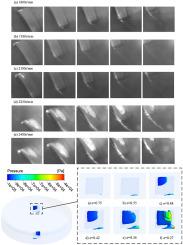不同空化数下旋转圆盘的空化流动特性研究
IF 2.7
3区 工程技术
Q2 ENGINEERING, MECHANICAL
引用次数: 0
摘要
空化一直是流体机械领域的研究热点。作为流体机械核心部件叶轮的组成部分,翼型的水动力特性和空化特性对流体机械的性能有着至关重要的影响。目前,固定式水翼船的空化流动特性已经得到了广泛的研究,但对旋转水翼船的空化流动特性的研究还很有限。本文以NACA 0015旋翼型为研究对象。采用实验与数值模拟相结合的方法,研究了不同空化数下不同转速下翼型周围的空化流动特性。同时,基于熵生理论,分析了空化引起的圆盘内能量损失特性。结果表明:旋翼盘空化数随转速的增加而减小,在所有空化数下,空化都发生在翼型尾缘,主要是尾迹效应所致。当空化数σ≤0.55时,翼型吸力面出现空化现象。随着空化数的减少,空化从前缘向尾缘延伸,加剧了空化现象,增加了盘的能量损失,这主要是由于低压区形成造成的。研究旋转盘的空化特性为液压机械的稳定、安全运行提供了理论支持。本文章由计算机程序翻译,如有差异,请以英文原文为准。

Research on cavitation flow characteristics of rotating disc under different cavitation numbers
Cavitation has always been a research hotspot in the field of fluid machinery. As one of the components of an impeller—the core component of fluid machinery—the hydrodynamic and cavitation characteristics of airfoils are of vital importance to fluid machinery performance. Currently, cavitation flow characteristics around stationary hydrofoils have been extensively studied, but research on rotating hydrofoils remains limited. This paper takes the NACA 0015 airfoil mounted on a rotating disc as a research object. By combining experimental and numerical simulation methods, it investigates the cavitation flow characteristics around the airfoil under different cavitation numbers by varying rotational speed. Meanwhile, based on entropy generation theory, the study analyzes energy loss characteristics in the disc induced by cavitation. Results show that the disc's cavitation number decreases with increasing rotational speed, and cavitation occurs at the airfoil trailing edge under all cavitation numbers, primarily due to wake effects. When the cavitation number σ ≤ 0.55, cavitation emerges on the airfoil suction surface. As the cavitation number decreases, cavitation extends from the leading to trailing edge, intensifying the phenomenon and increasing disc energy loss—largely caused by low-pressure region formation. Studying the rotating disc's cavitation characteristics provides theoretical support for the stable and safe operation of hydraulic machinery.
求助全文
通过发布文献求助,成功后即可免费获取论文全文。
去求助
来源期刊

Flow Measurement and Instrumentation
工程技术-工程:机械
CiteScore
4.30
自引率
13.60%
发文量
123
审稿时长
6 months
期刊介绍:
Flow Measurement and Instrumentation is dedicated to disseminating the latest research results on all aspects of flow measurement, in both closed conduits and open channels. The design of flow measurement systems involves a wide variety of multidisciplinary activities including modelling the flow sensor, the fluid flow and the sensor/fluid interactions through the use of computation techniques; the development of advanced transducer systems and their associated signal processing and the laboratory and field assessment of the overall system under ideal and disturbed conditions.
FMI is the essential forum for critical information exchange, and contributions are particularly encouraged in the following areas of interest:
Modelling: the application of mathematical and computational modelling to the interaction of fluid dynamics with flowmeters, including flowmeter behaviour, improved flowmeter design and installation problems. Application of CAD/CAE techniques to flowmeter modelling are eligible.
Design and development: the detailed design of the flowmeter head and/or signal processing aspects of novel flowmeters. Emphasis is given to papers identifying new sensor configurations, multisensor flow measurement systems, non-intrusive flow metering techniques and the application of microelectronic techniques in smart or intelligent systems.
Calibration techniques: including descriptions of new or existing calibration facilities and techniques, calibration data from different flowmeter types, and calibration intercomparison data from different laboratories.
Installation effect data: dealing with the effects of non-ideal flow conditions on flowmeters. Papers combining a theoretical understanding of flowmeter behaviour with experimental work are particularly welcome.
 求助内容:
求助内容: 应助结果提醒方式:
应助结果提醒方式:


